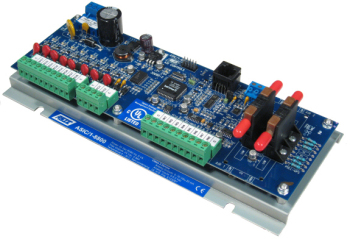ASIC/1-8800 Controller
Firmware History | Download Firmware | View Documents

ASIC/1-8800-DD
Quick Specs
Application-specific controller. It has personalities for control of pressure independent Variable Air Volume (VAV), Fan-Powered VAV, Dual Duct and Volume Tracking terminal units. Compare available sequences against your actual needs before selecting this controller.Needs power supply rated at 24 Vac. It draws 8 VA (plus loads). Available in single-duct ASIC/1-8800 version, and dual-duct ASIC/1-8800-DD version.
Point Count
- 8 Universal Inputs, 0-5 Vdc
- 8 Triac Binary Outputs
- 2 Analog Outputs, 0-10 Vdc
Application Overview
Point Count
- 8 Universal Inputs: These inputs are 0-5 Vdc, and can be configured as analog or binary inputs. With the use of the Quad MUX, a single input can be set up as four normally-open binary inputs. The input resolution is 12-bit.
- 8 Binary Outputs: These outputs are triacs, giving you a solid-state relay that switches the common leg of the power supply. All outputs share a common pole.
- 2 Analog Outputs: These outputs can provide a 0-10 Vdc signal. The output resolution is 8-bit.
Communications
The ASIC/1-8800 has a single RS-485 communication port. Available baud rates are 1200, 9600 or 19200. This is normally used on the local bus of an ASIC/2.
Applications
Straight VAV
The ASIC/1-8800 can handle straight VAV's, with up to three stages of electric reheat, and either a floating reheat valve or an on/off reheat valve. The analog output can be used to control a modulating reheat hot water valve.
Parallel Fan VAV
The ASIC/1-8800 can handle parallel fan-powered VAV's, with up to three stages of electric reheat, and either a floating reheat valve or an on/off reheat valve. The analog output can be used to control a modulating reheat hot water valve.
Series-powered Fan VAV
The ASIC/1-8800 can handle series fan-powered VAV's, with up to two stages of electric reheat, and either a floating reheat valve or an on/off reheat valve. The analog output can be used to control a modulating reheat hot water valve.
Dual-duct VAV
The ASIC/1-8800-DD can handle dual-duct VAV's, with and without blending. Two airflow sensors are provided on the ASIC/1-8800-DD controller.
Volume Tracking VAV
The ASIC/1-8800-DD can handle volume tracking VAV's, with up to three stages of electric reheat, and either a floating reheat valve or an on/off reheat valve. The analog output can be used to control a modulating reheat hot water valve. Two airflow sensors are provided on the ASIC/1-8800-DD controller.
Firmware History
Preliminary Firmware Release: ASIC/1-8800 FW880a0.4
FW880a0.4 (2009-02-23) adds personalities for Positive or Negative Volume Tracking.
In tracking personalities the primary airflow is modulated to control the zone temperature at the heating or cooling temperature setpoint. The secondary airflow is controlled to maintain an exhaust volume difference at all times. An option flag determines whether the Volume tracking is Positive (less air leaving the zone) or Negative (more air leaving the zone)..
Volume Tracking personalities include: VAV Cooling Only (Personality 21), 1 Stage Electric Heat (Personality 22), 2 Stage Electric Heat (Personality 23), HW Valve(Personality 24), and Thermic Valve (Personality 25).
Preliminary Firmware Release: ASIC/1-8800 FW880a0.2
Limited prototypes of the ASIC/1-8800 Single and Dual Duct controller are available for customer testing and evaluation.
- FW880a0.2 (2009-01-22) supports single and dual duct vav controllers.
ASIC/1-8800 FW880a0.2 also supports a new proportional plus integral airflow control algorithm that improves the approach to airflow setpoint. To enable this algorithm you must give the new Airflow Integration Time [Default 4] a non-zero value. If Airflow Integration Time is zero, then reverts to old algorithm. (Drive To Airflow Setpoint, and then wait until airflow exceeds hysteresis.)
As the damper drives the airflow toward the setpoint, the output begins to pulse, where the pulse size in 1/6 s increments is given by 4*Airflow Error/AF Hysteresis. The smallest non-zero Airflow Hysteresis gives the fastest approach to setpoint.
As control approaches the setpoint, the airflow error is summed over time. The Airflow Integration Time (T3 E48) is the time required for a 25 ft/min error to sum to give an additional pulse.
- Forthcoming releases will support Exhaust Volume Tracking applications.
For further information on this new product please contact customer support.